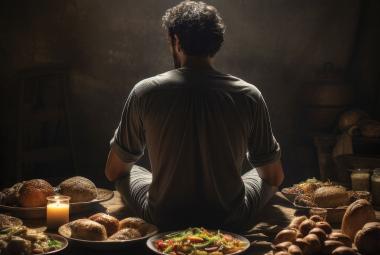Years ago, in one of David Wilkerson's1 newsletters, there was an article entitled, "The Making of a Man of God." I've never forgotten that intriguing title because, in a nutshell, this is what God is trying to do in all of our lives - make us men and women of God.
If we really want to know how one becomes a "man of God," we have only to look at Jesus. He is our example. He is our role model. In other words, there is nothing that can happen to us that Jesus has not already experienced. Thus, to be made "like Him," we must face life-altering struggles similar to those He faced. Now obviously not to the same degree of intensity that Jesus did, but we too must come to the end of ourselves (death of self) so that we can learn to walk by His Spirit.
This means that, at some point in our walk with the Lord, we too will experience rejection, confusion and loneliness just as Jesus did. Each of these situations will provide us with a greater opportunity to die a little more to our self and to grow a little more in grace and the image of God.
John 12:24 validates this principle: "Verily, verily I say unto you, Except a corn of wheat fall into the ground and die, it abideth alone: but if it die, it bringeth forth much fruit."
Total surrender and relinquishment seem to be the cost of "becoming a man of God."
Psalm 34:19 tells us that, "Many are the afflictions of the righteous," but if we yield ourselves to the Lord, He promises to deliver us out of all of them. Now, it's not our job to understand all that He is doing, but simply to surrender everything and trust Him in all that He is doing.
Surrender Is Key
David Wilkerson defines the term surrender as "giving up or relinquishing something to another that is granted to you." To me, this is a perfect explanation of surrender. When God calls us to surrender all to Him, He is simply asking us to give back the life that He granted us in the first place. In other words, we're not being forced to lay our lives down, it's a choice that we are making out of our own free will and out of our love for Him.
When all is said and done, I truly believe we will not only be judged by what we did for Him, but by how much we surrendered to Him, how much we loved Him and how much our hearts and lives were totally yielded to Him.
Love Vs. Worship
As we said last month, worship flows from love. The word used in Scripture for the verb "to love" is the Greek word agapao, which means "to totally give oneself over to something." Love for God, then, is not just an emotional feeling but a complete surrender of ourselves, heart, mind and soul. Consequently, when we don't know how to love God-how to completely surrender our lives to Him-we will never be able to truly worship Him.
Love comes before worship. Without Love, there is no worship. Therefore, we must learn how to love the Lord before we can learn to really worship Him.
We must totally give ourselves over to the Lord in order to become "cleansed" and, in order to experience the "beauty of His holiness." As we saw last month, being in the beauty of His holiness is the requirement for entering His presence and worshiping Him. It's also the requirement for staying there. We not only must have the boldness, the cleanliness and the purity to enter His holy place, we must also have the beauty of His holiness in order to remain there.
Jesus is our example and His walk, our blueprint. There are two evidences that Jesus loved the Father and was totally surrendered to Him. First, He was completely obedient to His will. Second, He experienced the manifestation of His Father's presence continually.
In order for us to prove that we love Jesus, we too must walk in complete obedience to His will. We must learn not only how to make faith choices to do His will, regardless of how we feel or what we think, but also how to become cleansed vessels so that we, too, can experience His presence.
The only other choice we have is to succumb to our emotions, our difficult circumstances and our trials, which, of course, will quench His Spirit in us and cause us to walk by the flesh. Again, our job is not necessarily to understand all that God allows into our lives but simply to trust Him in all that He allows.
In summary, we can only worship the Lord to the degree that we love Him - to the degree to which we are surrendered, cleansed and holy.
The Temple Revisited
Speaking of being totally relinquished to the Lord, let's turn for just a moment to the cleansing ceremony that the Lord ordained for the priests of Solomon's Temple.
Years ago, when I wrote my first book, The Way of Agape, the Lord led me to make a thorough exploration of the Temple of Solomon. I was fascinated by the similarities between the architecture of that temple and that of our own internal architectural design.
While in Jerusalem on one of our trips, I was able to spend some quality time in the Rockefeller Museum, gathering as much information on this subject as I could. Several rabbis studying in the library at the same time were delighted to help me with the project. They were so touched that a "goyim" (a Gentile) was interested in their sacred temple, that they brought me as many books as they could find on this subject written in English.
One of the reasons that this temple fascinated me so much was that there are over 52 chapters in the Bible that refer to it and its services in some way. In God's economy, I figured this must have some importance. If He dedicated that much space to this topic, He must be saying something extremely significant. Besides, Solomon's Temple was unique. It was the only temple in which the Spirit of God-the Shekinah Glory-permanently dwelt in the Holy of Holies. ( Exodus 25:22) In later temples, God's presence seemed to come and go. Also, Solomon's Temple was the only temple in which God gave King David precise directions for its construction and also for all its furnishings. ( 1 Chronicles 28:12 and 19) And, finally, Solomon's Temple was the only temple in which the Ark of the Covenant rested. By the time the other temples were built, it had disappeared. Solomon's Temple lasted for 410 years until it was finally destroyed by King Nebuchadnezzar.2
As I began to explore the intricacies of this fascinating temple - the Holy of Holies, the Holy Place, the Inner and Outer Courts - I began to see many parallels between its blueprint and the interior architecture of man (i.e., spirit, heart, soul and body).
For example, the hallmark of Solomon's Temple were the pillars that stood in front of the sanctuary called Jachin and Boaz (see picture). My first question to the Lord was: "Why did these pillars have names and why on earth, the names Jachin and Boaz?" These pillars weren't functional; they were simply there for show. So, why did God name them Jachin and Boaz? In the Old Testament, Boaz lived during the period of the Judges, around 1200 B.C. (See the book of Ruth.) Solomon's Temple wasn't even constructed until 200-300 years later, in the era of David and his son, Solomon. So, why the name Boaz?
Jachin means "in His Counsel" and Boaz means "by His Strength."
When I was studying and writing my book, Be Ye Transformed, the Lord validated over and over again the incredible comparison, not only between the floorplan of Solomon's Temple and the interior architecture of man, but also between the features and furnishings of that temple and the components that make up the Mind of Christ in us. 1 Corinthians 3:16 validates this, "Know ye not that ye are the temple of God, and that the Spirit of God dwelleth in you?"
If you line up the features of the Mind of Christ as listed in Isaiah 11-the Spirit of the Lord, the Spirit of wisdom and understanding, the spirit of counsel and strength, and the spirit of knowledge and fear of the Lord - with the physical features and furnishings of the temple, the two pillars, Jachin (which means counsel) and Boaz (which means strength), align perfectly with the spirit of counsel and strength. All the other components of the Mind of Christ also line up perfectly with their corresponding feature in the temple. (If you are interested in further details, check out Chapter 13 in Be Ye Transformed.)
Is this just a coincidence? I don't think so! To me, it validates the handprint of God and the Divine connection between the architecture of man and the interior design of Solomon's Temple.3
Thus, there are important principles that we can glean from studying Solomon's Temple and the ceremonies that God ordained there for worship. The Lord tells us that everything in the Bible, from the smallest detail to the greatest, is there for our learning. ( Romans 15:4) In other words, He has given us many visual pictures and graphic examples throughout the Bible to help us understand His ways a little more clearly. Solomon's Temple is definitely one of these.
The Order of Worship in Solomon's Temple
So how did the priests in this temple worship the Lord? What was their order of service like?
See Chart. This is the blueprint of Solomon's Temple. This month, I'll just give you an "overall picture" of this temple and its services. But next month, we'll have time to explore each of these areas in greater detail.
The worship service began as the Levites opened the Outer Court gate for the people to come in and they all began to sing and praise the Lord. Then, the priests alone entered the Inner Court and immediately went to the Lavers of Bronze where they washed their hands and feet. After that they approached the Brazen Altar (or Holocaust Altar), where they sacrificed their animals in order to purge the sins of the people. Next, they immersed themselves bodily in the Molten Sea. And, finally, they took a censer full of hot coals from the Brazen Altar, went back into the Holy Place where they changed their clothes, took some incense and sprinkled it over the coals at the Golden Incense Altar where God promised to "meet with them." ( Exodus 25:22) Approaching the Golden Altar of Incense, they took off their shoes, prostrated themselves and worshiped the Lord in the "beauty of holiness."
1 Chronicles 16:29 tells us, "Give unto the Lord the glory due unto His name; bring an offering, and come before Him; worship the Lord in the beauty of holiness." (See also Psalm 29:2 ; 96:9 )
Upon leaving the Holy Place, the priests then shared with the people (who had gathered in the Outer Court) from the fullness of the Lord (or the anointing) that they had received from the Lord at the Golden Altar. One of the passages they recited was Numbers 6:24-26: "The Lord bless thee, and keep thee; the Lord make His face shine upon thee, and be gracious unto thee; the Lord lift up His countenance upon thee, and give thee peace." They repeated this entire ceremony twice a day, once in the morning and once at night.
How Does This Apply to Us?
The question is: How does this Jewish, Old Testament, Old Covenant temple service apply with us Gentile, New Testament, New Covenant believers? In other words, can we use what we are learning here and make application to our own daily devotional times? And, if so, how?
I do not mean to imply that there is some sort of ritual or ceremony required in order to work our way to heaven. There is not. We are saved by grace. However, I do believe that God has given us a "set of guidelines" here and that by following these suggestions, our devotional times will not only be more acceptable to Him, but also be a huge blessing to us.
Of course, the most important thing is to always allow the Holy Spirit the freedom to direct us as He wills. He is the only One who knows the perfect and the best personal way for us to worship.
Next month, then, we'll embark upon a brief exploration of Solomon's Temple and its services, and see if there is any connection to what the Word of God says about worshiping. Does God somehow want us to apply this priestly worship service in our own lives. And, again, if so, how?
Notes:
- Pastor of Times Square Church in New York City.
- See the picture of the temple on page 34-35 in The Light of the Temple book.
- See Be Ye Transformed for more details.




